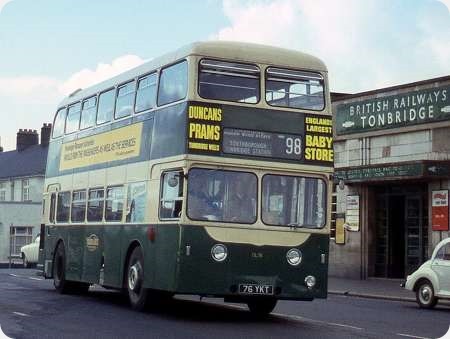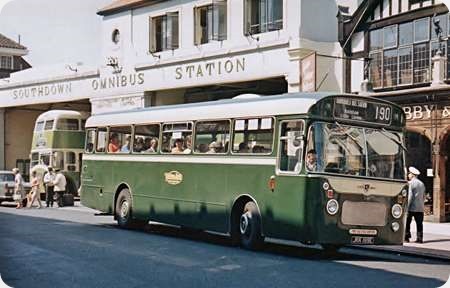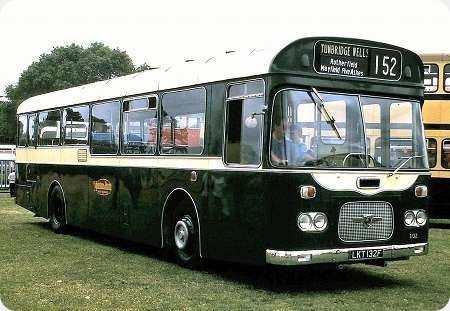Maidstone & District – Daimler Fleetline – 76 YKT – DL76
Maidstone & District
1964
Daimler Fleetline CRG6LX
Northern Counties H44/35F
Maidstone and District was an early user of the Leyland Atlantean, taking both normal and lowheight examples classified DH and DL respectively, from 1959 until 1963, when the Daimler Fleetline became the favoured choice. CRG6LX No.DL76, 76 YKT was delivered in September 1964. The Northern Counties body is shown as H44/35F on BLOTW but elsewhere is stated to be H44/33F. DL76 is seen in Tonbridge on 1st October 1967 by which time the BET was concluding negotiations with a view to the sale of its bus industry interests to the government. The imperfect state of the front panel of DL 76 indicates some prescience of the future world awaiting it under NBC.
Photograph and Copy contributed by Roger Cox
17/01/18 – 06:31
H44/33F seems more likely. The first Atlanteans of my local BET operator, Tynemouth and District had H44/34F seating, reduced on the next batch of Atlanteans, and the first batch of Daimler Fleetlines to H44/33F. This was achieved by reducing the inward facing seat over the front wheel arch from 3 to 2. 34 seems to be the maximum that could easily be fitted in downstairs, 35, although not impossible, would imply very cramped seating.
John Gibson
17/01/18 – 06:33
Roger, I would interpret the bent front panel another way – all was not perfect before National Bus company was formed whatever some fondly like to remember! Had it not been formed I would not have arrived at M&D from Eastern Counties in January 1970! It is perhaps an appropriate location to remind us of Mr Macawber: Annual income twenty pounds, annual expenditure twenty pounds ought and six, result misery! Perhaps the main reason BET were willing to sell out!
At that time all the M&D Fleetline DD were 77 seaters as indeed were the highbridge Atlanteans (according to the 1971 fleet list). DL 76 > 6076 was still at Tonbridge in 1971 having been converted to "OMB" as was the current expression. Tonbridge had no bodybuilders and had a small running shift, so it was no doubt waiting to go to Tunbridge Wells for repair – the dreadful split level garage that was eventually closed only in 2017!
See also www.old-bus-photos.co.uk/m_&_d_selected_memories.php
Geoff Pullin
17/01/18 – 06:33
Northern Counties made one of the best jobs of bodying the first generation rear engined buses. The engine shrouds hide the rear end bustle and the proportions look just right. In this instance the whole show was helped by a tasteful traditional livery that fitted the lines of the body. Although a bit boxy I thought the flat screens were better than the later versions where BET style curved windscreens were grafted on and never seemed to blend in right.
Philip Halstead
17/01/18 – 06:34
Nice looking bus, the livery helps. We had similar at PMT new in 1963. They were specified with a seating material called Replin which quickly became very soiled and were later retrimmed in very basic red vinyde. I prefer the M&D single headlamps to the twin headlamps fitted to the PMT batch. I like the Southern Region green Station nameboard!
Ian Wild
18/01/18 – 05:28
Not being familiar with the M&D fleet, I’m assuming that the prefixes DL and DH referred to the overall height rather than the upper-deck seating layout, hence the Fleetlines were DL as they had the drop-centre rear axle.
Geoff Kerr
21/01/18 – 06:22
The old M & D garage at Tunbridge Wells was originally operated by Autocar and was in existence prior to 1933 when London Transport expected to acquire it(they had to make do with the little garage in Whitefield Road which became the operating base for Greenline 704)The garage faced directly onto the main road and also Woodbury Park Road.Why do todays operators consider covered accommodation unnecessary?
Patrick Armstrong
24/03/18 – 06:17
A quick reply to Geoff Kerr; DH referred to ‘Diesel Highbridge’ and DL to ‘Diesel Lowbridge in the Maidstone & District fleet. I was not a lover of the Fleetline because, as a driver, I found the engine tended to resonate through the bodywork into the cab and would give me a severe headache after an hour! That is if the engine was not perfectly tuned and many ‘bus engine was not perfect! I also once had the misfortune to have an engine cowl corner fall away from the body and dragged it along road by the cables when returning to Maidstone from West Malling.
Freddie Weston
24/03/18 – 18:13
The ‘D’ stood for ‘Double Deck’, not ‘Diesel’, Freddie. The corresponding Single Deck code was ‘S’.
Roger Cox
07/06/18 – 05:27
Having known many M&D staff over the years I can say that TW was not very good at looking after vehicles. Many were the PD2s and Reliances that managed to mysteriously get to Brighton so that Edward Street fitters could do a brake reline or other maintenance task that TW didn’t want to do. It was very noticeable in old M&D days that the vehicles from GR & H would be very well looked after, whereas TWs looked like bumper cars.
Bob Cornford
28/05/22 – 06:30
The seventh edition of Ian Allan’s British Bus Fleets, Area 1 South East which I believe was dated 1966 as the latest buses shown have delivery dates in 1965 shows the M&D Fleetlines in a class from DL57-DL111 built in two batches, 1963 and 1965. DL76 was one of the earlier batch. They were all Daimler Fleetline CRG6LX with Northern Counties LD77F (LD is defined as lowbridge with a central upper deck gangway) seating 77 with front entrance. There is a note that some were to be converted to CO77F (CO is defined as a convertible open top double deck bus). They operated my then local route 97 after the AEC Regent V DLs that I took to school although the route subsequently went to single deckers despite the Horsmonden rail bridge being removed.
Rob Weller
31/05/22 – 05:47
Firstly, the LD code mentioned by Rob Weller is no longer used. It was fine when there were just two heights of double decker – high (H) and low (L or LD depending on layout). But then operators started specifying intermediate heights, and there was no clear dividing line between H and LD. So LD was dropped, and now the distinction is purely about layout – H for a double decker with a centre gangway, regardless of height, and L for lowbridge with a sunken side gangway for at least a part of the bus’s length. Frankly I’m very surprised at a 1966 Ian Allan publication using LD, as I have an earlier edition of BBF19 which shows all of Crosville’s Bristol Lodekkas as H.
Secondly, for operators with low bridges to contend with, what matters is the overall height rather than the layout, hence M&D’s use of DL for these Fleetlines.
Peter Williamson
Quick links to the - Comments Page - Contact Page - Home Page




